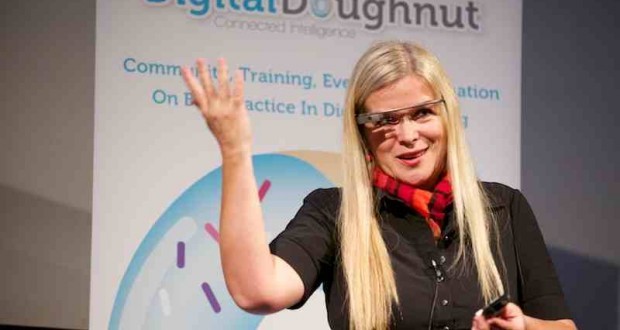
Say ‘Good Bye’ to your smartphone, it’s been (not) nice carrying you around…
A few days ago I joined the ranks of the Glass Explorers, the experimental program run by Google to investigate what humans will do once equipped with this mysterious life-logging device masquerading as glasses.
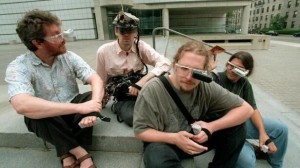
Early Glass models courtesy of Isabel Olsson
How did I get involved? Well it’s a long story which involves the Sultan of Brunei, a cancelled flight to LA and an argument with investors.
Inspired by the serenely beautiful Isabelle Olsson, the Lead Designer of Glass, I yearned to get my hands on one of the most exclusive eyewear in town, and to earn its keep, I hit the town in true explorer-style to come up with new uses for it.
My First Warning: Addiction
My first warning comes straight away: it is a pretty dangerous piece of kit. It is light, elegantly designed and less conspicuous than it appears in the photographs. With my long hair falling on my face I can minimise the noticeability of Glass significantly. The danger comes with its alarmingly high level of addiction. If you have an issue with your smartphone usage you will definitely have a problem with Glass. I put it on in the morning, and only take off for charging. (The batteries are an issue as it syncs with your phone, affecting your phone battery life too).
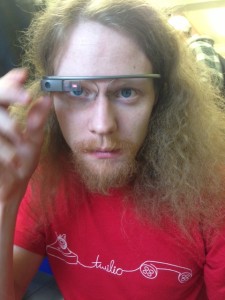
Simon
With the new XE11 software update, Glass allows you to use voice commands to see upcoming appointments, these are projected on the screen that albeit tiny, acts as if it was a 25inch once your eyes adjust. So amazingly it is very clear. The Google Calendar is a great app for me, as my days are packed and mainly out of the office, so I am always trying to check where I need to be next. It may be a different story if you’re mainly office based, as then you’d use more of a search-and-recall type of tool, as noted by Ed Saperia from Wikimania.

Ed Saperia
With Glass it’s not a simple thing to be on the move and stay on the same network, as there are so many networks out there, competing for attention. As Nico Macdonald found out, whilst testing Glass for me in the glamorous surroundings of the Hoxton Hotel, he could move his head up and down and shake it connect to the wifi. To those that know it, the Hoxton Hotel is the loveliest geek-bar-and-grill in Shoreditch, but the wi-fi is suboptimal.
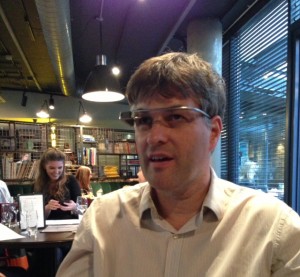
Nico Mcdonald
Driving with Glass
The trouble starts with the fact that although Glass really is a well designed hands-free camera and voice –to-text device, it is also quite seductive and gives you the illusion that you can walk or drive while taking photos and sending messages. It gives you a certain sense of confidence that using it will not impede your primary task of actually getting from A to B safely; it lets you communicate on- line while multitasking, seemingly without causing harm to others. It also improves your own safety as you stop bumping into lamp posts or getting run over whilst texting.
The retinal display is seemingly of a non-interfering type, and is just sitting in the corner of your field of vision quietly, waiting to be activated. Niki Gomez from The Retail Practice/Cybersalon tried it on in the car and managed to get good use out of it despite noise and movement of the car. However, the UK just rolled out a proposed legislation to ban the use of Glass while driving or cycling.
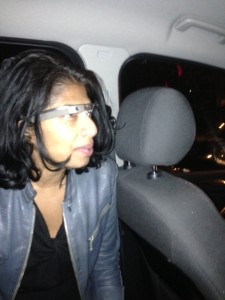
Niki Gomez tests Glass as a back seat driver
A recent study from the Texas A&M Transportation Institute shows that drivers perform significantly worse texting or sending texts via a hands-free system (i.e through voice) as compared to not texting at all. Putting it simply, it is an illusion that you are safer with the voice interface. Surprisingly it makes no difference, as the same amount of brain power is dedicated to texting, and that amount is taken away from focusing on the car and driving function. Many states in US have practically banned hands-free phones and are considering further action.
It all kicked off when in early November 2013 Cecillia Abadie got the first Google Glass driver’s fine, simply for driving whilst wearing Glass. The US police were adamant that it contravened the rule about using additional screens (a law created to stop people watching TV while driving). The fact that we all use additional screen (GPS devices) whilst driving was somewhat lost in the legal quagmire. The FAQs from Google are pretty firm, you have to read the law and follow it. They ain’t gonna help you.
Glass is also banned in casinos and in cinemas, although I have to confess I took it into my local cinema with no trouble at all. Since it was Thor: the Dark World, I took a few snippets of video with Chris Hemsworth (for Explorer research purposes only of course) without anyone noticing a thing.
It’s too early to say where I stand on the driving issue but my gut feeling is that a map HUDs (Head-Up-Display) on your windscreen would probably be better than the current GPS or Glass solution. From my dark past as a UI PhD student I remember that HUDs displays absorb a lot less of our brain power and distract us much less from the primary task, as compared to any screen close to the eye. This is why these HUDs are so successful with professional pilots, a direction that the car industry should explore for safety purposes.
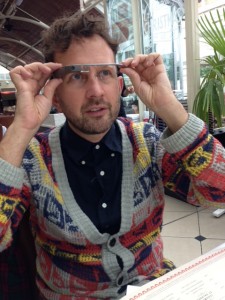
Wessel Van Rensburg
The glory of hands free, voice- activated spectacles
The upsides? The delight of using Glass as memory aid during my recent talk at Digital Doughnut with a photo summary of my slides on my Glass screen that I could glance up at, whilst talking to the audience must be up there with the best of efficiency gizmos. It would help to have a hand-held interface, as I had to stop during the talk and say “OK Glass, take a photo of the audience”, which is not ideal to say the least, and similarly for switching the slides on the display. A simple, small remote would be a very welcome addition to Glass.
And cracking the big nut- Privacy
I have to say privacy was a lot less problematic than I expected. Firstly, Glass is quite conspicuous. You can’t really blend in wearing it, even with the longest of hair and it would make very poor spy equipment! In fact, it is a lot easier to catch a sneaky photo of a friend while she is not looking using a normal smartphone than using Glass. The voice interface makes you a very poor Mata Hari, so despite my strong German- spy accent, I am not any closer to my secret agent capabilities with Glass. I tried to take a few photos at the London 3D Printing Show in Islington and got mobbed instantaneously. As soon as I said “OK Glass” everyone noticed I was trying to get a photo, and rather than object, I had a impromptu testing group around me in 2 minutes flat.
The kids ‘get it’ in an instant, with my 10 year old immediately finding ways to play and use Glass with his games. The friends of my daughter, 13 going 17, the SnapChat generation, immediately started taking photos and sharing them like mad with the whole network, without a glance at my privacy settings .
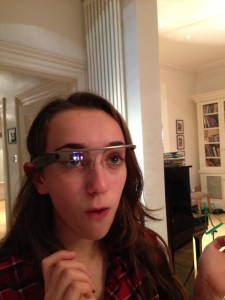
Tatiana
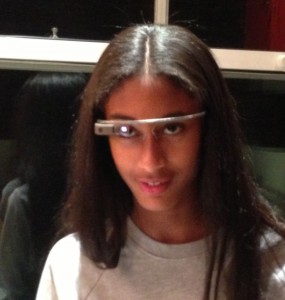
Emilia
The privacy is a bit odd right now, as it is experimental and at developer-stage. I do get the occasional random photos or video from other Explorers who are on the network. They just sort of float in, and make passing contact, then float out. It reminds me of the early days of Bulletin Boards, when there was very few of us on the Net and finding another human ‘out there’ was a great joy and delight. The Glass community provides that same sense of pioneering spirit, with a few lonely souls wandering around in the dark trying to make contact with the other Glass Explorers. Of course that sense of small, close community will be lost when Glass goes public, but at the moment it is a lovely bonus and I am meeting some very eccentric types on the circuit.
Voice Recognition
Dr Rick Robinson, the creative Lead Architect for IBM’s Smart Cities UK and I noticed it is somewhat hard to share Glass, as it clearly adapts to accents. Yes even to mine, and it takes time to re-adapt to another speaker. (Well done to the voice- recognition team).
Corrective glasses wearers
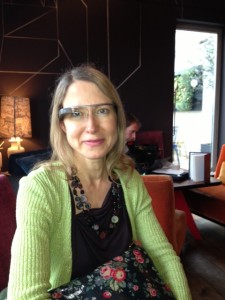
Jemima Gibbons
I also noticed a real issue with users that normally wear corrective glasses. Jemima Gibbons, a long –standing Wikipedia editor (one of a minority of women in that role) who spends a lot of time with screens and wear strong corrective glasses, managed to get a bit of interactive action from Glass but it needs to be said that a clip-on on your real glasses would probably be a better option.
Eva the Enhanced?
Since getting used to the experience and finding new ways to use Glass, I feel that I have actually walked through a magic door. I now live much more in cyberspace, or perhaps it is that cyberspace came out of the computer screen and wrapped itself around me like a comfy blanket.
Either I have became ‘enhanced’, with the ability to float in and out of the data universe with seamless ease or it is that Glass enhances cyberspace. It’s still too early to say. However you judge the interface, the sense of integration with the great river of data and news, photos and videos, Soundcloud and Wikipedia have certainly progressed a notch or two with ‘eye-up-display’. This is different from Head-Up Displays (HUDs) as the former allows for a much more intimate interaction with external sources of data.
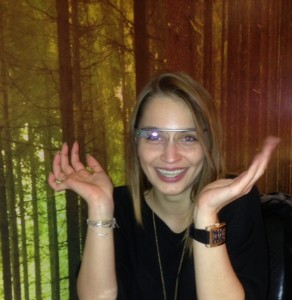
Adriana
Google+
My Glass Explorer adventures culminate at the evening launch of fashion forward shoe label Miista’s new collection at a glam Covent Garden shoe shop with an evocative name, Poste Mistress. With a glass of champagne in one hand and a stack of amazing shoes in other, I am free to take photos and videos via Glass and report from the shoe avant-garde without having to fidget with my smartphone. The party is buzzing as not only is Laura Villasenin, Missta’s founder, one of the most up-and-coming London shoe designers, but also there is a semi-naked model in the front window, reclining on a sheet of deep green velvet, causing great interest from the passing crowd.
The paparazzi ease-of-use of Glass is good, and beats a smartphone or camera for reporting options by a long way, particularly as you can share the photos with Google+ friends instantaneously. Ah yes, the sharing, naturally, is only with Google+ friends. That is if you have any, I had to go bravely into the Google+ wilderness and find some natives. It was not my normal beat.
It remains to be seen if Glass proves to be the killer app for Google+, as the company fights a seeming losing battle in the age of awareness of surveillance by US-based cloud companies. But macro-tech-politics nothwithstanding (see http://cybersalong.org/privacy) whatever you do with Glass when you get it, do not take photos or dictate emails while driving, we know now that this is one area that even the most gizmo-oriented techie should refrain from. Not just for your own safety but for the safety of others on the road.
Over time, Glass-like devices will replace your phone, as Eye-Up-Displays are clearly much more ergonomic than a stand-alone phone. But we need to start negociating not just the safe use law, privacy framework, health aspects and other issues that will no doubt crop up. We must avoid being caught unaware, as we did time and time again with other game-changing tech inventions like Facebook, the smartphone or Big Data of the Big Brother flavour.
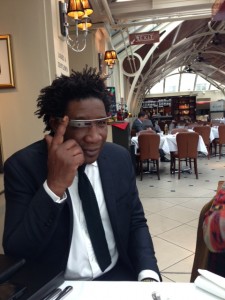
Jo Mosaku
Eva Pascoe is Chair of Cybersalon and Head of Digital Futures at The Retail Practice